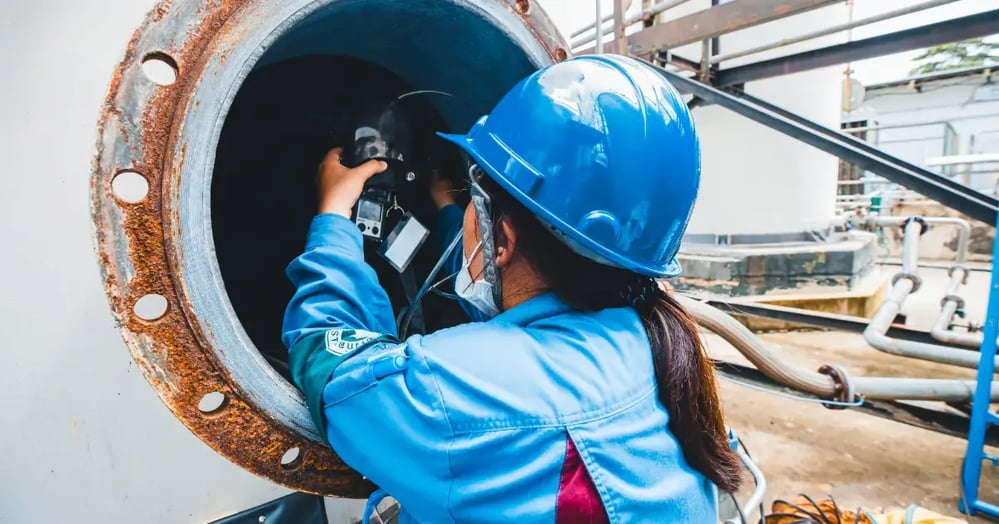What Does a 4-Gas Monitor Detect?
by Team Tradify, November 21, 2024

A 4-gas monitor detects oxygen (O2), carbon monoxide (CO), hydrogen sulphide (H2S), and combustible gases, often measured as Lower Explosive Limit (LEL). For anyone working near gas or potentially hazardous areas, knowing how to use a 4-gas monitor may save your life.
Check your team is aware of onsite dangers with a free H&S checklist
Low on time? Skip ahead!
- What is a 4-gas monitor?
- What does a 4-gas monitor detect?
- When to use a 4-gas monitors
- How to use a 4-gas monitor
- Safe gas exposure levels
- Caring for your 4-gas monitor
- Our top picks for 4-gas monitors
1. What is a 4-gas monitor?
A 4-gas monitor is a portable, battery-powered device that detects four main gases: Oxygen (O2), Carbon Monoxide (CO), Hydrogen Sulphide (H2S), and Combustible Gases (LEL). It gives real-time gas level read-outs with alarms to immediately warn when there is an unsafe level of gas in an area. They are essential for anyone who works within confined spaces, or carries out gas line installations and leak detection.
2. What does a 4-gas monitor detect?
A 4-gas monitor detects when unsafe levels of the following gases are detectable:
Oxygen (O2)
To breathe safely, air needs an oxygen level of at least 19.5%. Anything below this is a hazard and can lead to symptoms such as dizziness, confusion, or even loss of consciousness.
- Why it matters: Confined spaces, such as storage tanks, basements, or crawlspaces, often have low oxygen levels due to poor ventilation or the oxygen has been displaced by other gases.
Carbon monoxide (CO)
Carbon monoxide is a toxic, odourless, potentially deathly and colourless gas, often referred to as a "silent killer." It is produced by combustion engines, or by fuel-powered tools, heaters, or other equipment operating in poorly ventilated areas.
- Why it matters: This gas is particularly common near fuel-powered tools or heating systems used in enclosed spaces and can cause headaches, nausea or death.
Hydrogen sulphide (H2S)
Hydrogen sulphide is a highly toxic gas commonly associated with sewer systems or the decomposition of organic materials. Chances are, you'd be able to smell it — at first. However, at high concentrations, it can numb the sense of smell, making it even more dangerous as workers may not detect it.
- Why it matters: Tasks such as sewer work, excavation near organic waste, or industrial processes can expose workers to hydrogen sulphide, necessitating proper detection and safety measures.
Combustible gases (LEL)
Combustible gases, like methane, propane, and butane, pose a significant risk of fire or explosion if their concentrations reach the Lower Explosive Limit (LEL). They can build up undetected in poorly ventilated areas.
- Why it matters: Gas line installations, repairs, and leak testing frequently involve exposure to combustible gases. Proper monitoring ensures safety by detecting dangerous concentrations before they become critical.
3. When to use a 4-gas monitors
Properly using a 4-gas monitor is particularly critical for your safety during:
- Leak detection: Check for methane leaks in gas lines.
- Confined spaces: Test the air quality in crawlspaces or tanks.
- Boiler and heater installation: Ensure safe CO levels during system tests.
- Emergency response: Identify hazardous gases after a suspected gas explosion.
- Wastewater Treatment: Ensure the air quality in sewer systems and treatment facilities to avoid exposure to hydrogen sulphide and other hazardous gases.
4. How to use a 4-gas monitor
Although the exact way to operate a 4-gas monitor will change per unit, follow these basic steps to ensure yours is working properly:
- Inspection: Ensure the monitor is clean, calibrated, and has sufficient battery.
- Bump test: Perform a quick test to confirm sensor responsiveness.
- Fresh air setup: Turn on in a clean environment to set a baseline.
- Monitoring: Move slowly through areas, allowing time for readings to stabilise.
- Reacting to alarms: Understand low and high alarms and take appropriate action.
5. Safe gas exposure levels
The following table outlines the safe levels for gases commonly monitored by a 4-gas detector. These levels are defined by organisations like OSHA (Occupational Safety and Health Administration), NIOSH (National Institute for Occupational Safety and Health), and ACGIH (American Conference of Governmental Industrial Hygienists).
| Gas | Low Alarm | High Alarm | TWA | STEL |
|---|---|---|---|---|
| Oxygen (O2) | 19.5% vol | 23.5% vol | N/A | N/A |
| Carbon Monoxide (CO) | 35 ppm | 70 ppm | 35 ppm | 200 ppm |
| Carbon Dioxide (CO2) | 0.5% vol | 1.0% vol | 0.5% vol | 3.0% vol |
| Ammonia (NH3) | 25 ppm | 50 ppm | 25 ppm | 35 ppm |
| Methane (CH4) | 1.0% vol | 1.5% vol | N/A | N/A |
| Hydrogen Sulfide (H2S) | 10 ppm | 20 ppm | 10 ppm | 15 ppm |
| Sulfur Dioxide (SO2) | 2.0 ppm | 4.0 ppm | 2.0 ppm | 5.0 ppm |
| Nitrogen Dioxide (NO2) | 3.0 ppm | 6.0 ppm | 3.0 ppm | 5.0 ppm |
| Nitric Oxide (NO) | 25 ppm | 50 ppm | 25 ppm | 25 ppm |
6. Caring for your 4-gas monitor
Explain maintenance tips to keep the monitor reliable:
- Store in a protective case and within safe temperature ranges.
- Avoid exposing it to corrosive gases or harsh environments.
- Regularly calibrate as per the manufacturer’s instructions.
7. Our top picks for 4-gas monitors
MSA ALTAIR® 4XR Multigas Detector
This detector features rapid-response MSA XCell® sensors and offers a 4-year warranty. It monitors combustible gases, oxygen, carbon monoxide, and hydrogen sulfide. The device is known for its durability, surviving drops from up to 25 feet, and operates in temperatures ranging from -40°F to +140°F (-40°C to +60°C). It also provides real-time incident awareness when paired with the MSA ALTAIR Connect app.

Honeywell BW ICON-Y-H Multi-Gas Detector ICON with Bluetooth
This detector has an icon-based interface in a serviceable package, monitoring hydrogen sulphide, carbon monoxide, oxygen, and combustible gases. It's battery runtime lasts up to two months on a 4.5-hour charge and utilises a low-power infrared LEL sensor immune to silicone poisoning. The device is lightweight, features one-button operation, and is compatible with the IntelliDoX instrument management system and Honeywell Safety Suite.

Dräger X-am® 2500 Gas Detector
This smaller detector still reliably measures combustible gases and vapours, as well as oxygen, carbon monoxide, hydrogen sulphide, nitrogen dioxide, and sulphur dioxide. It features durable sensors and offers reliable measuring technology.
🏆 The best all-in-one management tool for trade businesses
Tradify is a job management app used by thousands of trade professionals to build better lives and businesses all over the world. It gives you all the features needed to manage and grow a successful trade business, including:
Start your 14-day free trial today. No credit card required. No pressure. Or take a look at Tradify in action during one of our weekly 30-min live walkthrough.
Related articles

No More Night Shifts for Aro Electrical

AEE Yorkshire Back on Track With Automated Systems

No More Invoice Mistakes for DMS Plumbing
Give Tradify a go for free!
Save 10+ hours/week on business admin with the highest-rated job management software for tradespeople.
With free one-on-one training and phone support, it's never been easier to get started.




